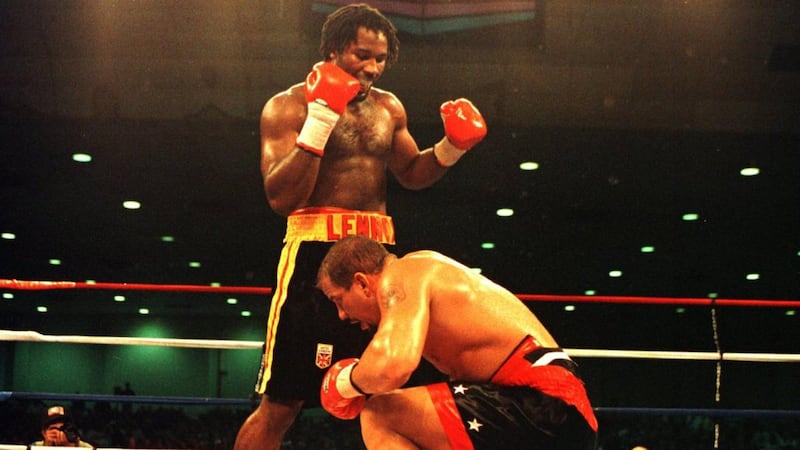At 10 years old, Tommy Morrison’s mother gave him his first tattoo, etching a crude pair of boxing gloves on to his arm. Not long after that, his alcoholic, abusive father granted him access to the pornography he kept in his house and truck.
By 13, the kid was fighting unregulated Toughman contests against grown men wearing jeans and work boots at fair grounds and honky tonks across the midwest. An unlikely breeding ground for a future heavyweight champion, his exploits in those most anarchic arenas supposedly earned him a role as an enforcer with the Missouri mob while still in his teens.
His own tragi-comic criminal record included once being arrested for fighting outside a police station where he had gone to post bail for a beleaguered member of his entourage. Another night, the cops chased him through the woods after he fled the scene of a car crash involving his close friend, Bart Bumpass.
Of the litany of DUIs on his blotter, the standout was getting picked up barreling home drunk from a high school where he had just spoke to students at length about the dangers of excess. More sensible evenings often culminated in him being peeled off a sawdust floor and hurled comatose into the back of a pick-up truck for the journey home.
Rocky fans will remember him as Tommy 'The Machine' Gunn in the execrable fifth instalment of Sylvester Stallone's franchise <br/>
That's only a sample of the astonishing, hilarious, and disturbing detail contained in The Duke – The Life and Lies of Tommy Morrison, an enthralling new biography by Carlos Acevedo. He may have held an iteration of the heavyweight belt for just a matter of months in the 1990s, a particularly undistinguished decade for the division, but Morrison's Falstaffian story makes for a rollicking read in Acevedo's deft hands.
Witness the way this demented soul reacted when, despite turning and running away at one point during the contest, he somehow defeated a 44-year-old George Foreman for the vacant WBO heavyweight title in 1993.
“Beating Foreman meant a celebration was in order, and, for Morrison, part of celebrating meant gang bangs, trios, trains, toilet-stall romps,” writes Acevedo. “Some of it, most of it, probably all of it-in the raw and without regret. Morrison bar-hopped and bed-hopped through the blue hours in Westport accompanied by a famished entourage eager to split the leftover spoils from associating with a genuine local hero. Even with fame and money, Morrison was less than discriminating about his cravings . . . partying in a seedy hot-sheets motel, where registered guests comprised an informal listing of select lowlife in ‘The Paris of the Plains’.”
Debauchery was his default setting. Along with drink and drugs, his prodigious sexual appetite (he used to inject a performance-enhancer direct into his penis before sex) was his downfall. By the time he was diagnosed HIV positive in a pre-fight medical in 1996, he was already a busted flush in the ring, waylaid by the celebrity and money bestowed on the latest “Great White Hope”.

Although his family bristled at that description because his mother was part Native American, his ersatz professional ledger of 48 wins, three losses and one draw was the result of careful husbandry by management adept at unearthing useful stumblebums to pad his record and cash in on his popularity across middle America.
Rocky fans will remember him as Tommy ‘The Machine’ Gunn in the execrable fifth instalment of Sylvester Stallone’s franchise. The movie elevated his profile far beyond his talent and seriously improved his physique because Hollywood apparently introduced him to the wonder of steroids. Later in life, his quest to regain the sculpted, pneumatic body of his misspent youth led him to visit underground plastic surgeons and one of those quasi-medical misadventures ended with him wasted, ripping leaking implants out of his own arms in a bar.
This meticulously reported book is brimming with startling yarns of that ilk. Like the time Morrison ended up simultaneously married to two long-suffering women, both of whom happened to be named Dawn. Or the period where he became a doomsday prepper during the build-up to Y2K, began subscribing to conspiracy theories, and, for a time, joined the ranks of those denying that Aids, the very disease ravaging his own body, even existed. Like the very best biographers, Acevedo never stints from painting the full portrait, no matter how grotesque the subject ends up looking.
“A racist, homophobic, mendacious felon with a history of delusional thinking, Morrison could hardly be considered a reputable character,” writes Acevedo. “Over and over, Morrison bragged about living a healthy lifestyle to combat HIV naturally, repeatedly saying that he would never even take an aspirin. At the same time, he was consuming methamphetamine, shooting up Adderall, snorting cocaine, smoking cigarettes and cigars, getting arrested frequently for DUIs, and once even taking Special K, a horse tranquiliser that left him in shambles.”
As inevitably as his artificially enhanced boxing record was finally exposed, there was a tragic denouement to the Morrison tale. After years in prison, several abortive comebacks on the fringes of the sport, and a lot of claiming that HIV was a government plot, he died in 2013 at just 44. Reading Acevedo’s extraordinarily forensic account of how he lived, there is no mystery as to how he went so young. The real question is how he managed to stay alive that long.
– The Duke – The Life and Lies of Tommy Morrison by Carlos Acevedo is published by Hamilcar and available next month.















